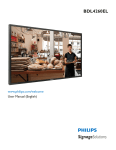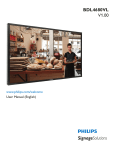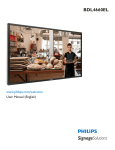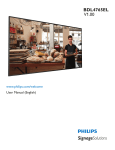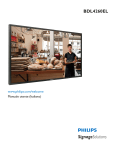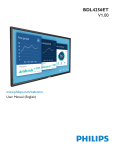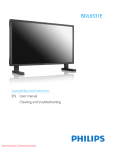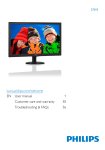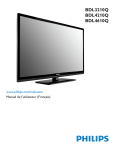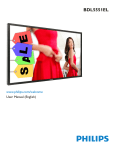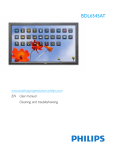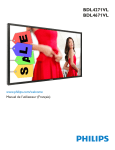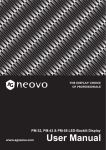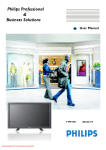Download BDL6520QL V1.00
Transcript
BDL6520QL
V1.00
www.philips.com/welcome
User Manual (English)
BDL6520QL
Safety Instructions
Safety precautions and maintenance
WARNING: Use of controls, adjustments or procedures other than those specified in this documentation may result in exposure to
shock, electrical hazards and/or mechanical hazards.
Read and follow these instructions when connecting and using your display:
Operation:
• Keep the display out of direct sunlight and away from stoves or any other heat sources.
• Remove any object that could fall into ventilation holes or prevent proper cooling of the display’s electronics.
• Do not block the ventilation holes on the cabinet.
• When positioning the display, make sure the power plug and outlet are easily accessible.
• When turning off the display by detaching the power cord, wait 6 seconds before re-attaching the power cord for normal operation.
• Ensure the use of an approved power cord provided by Philips at all times. If your power cord is missing, please contact your local service center.
• Do not subject the display to severe vibration or high impact conditions during operation.
• Do not knock or drop the display during operation or transportation.
Maintenance:
• To protect your display from possible damage, do not put excessive pressure on the LCD panel. When moving your display, grasp the frame to lift; do
not lift the display by placing your hand or fingers on the LCD panel.
• Unplug the display if you are not going to use it for an extensive period of time.
• Unplug the display if you need to clean it with a slightly damp cloth. The screen may be wiped with a dry cloth when the power is off. However, never
use organic solvent, such as, alcohol, or ammonia-based liquids to clean your display.
• To avoid the risk of shock or permanent damage to the set, do not expose the display to dust, rain, water or an excessively moist environment.
• If your display becomes wet, wipe it with dry cloth as soon as possible.
• If a foreign substance or water gets in your display, turn the power off immediately and disconnect the power cord. Then remove the foreign substance
or water, and send the unit to the maintenance center.
• Do not store or use the display in locations exposed to heat, direct sunlight or extreme cold.
• In order to maintain the best performance of your display and ensure a longer lifetime, we strongly recommend using the display in a location that falls
within the following temperature and humidity ranges.
-- Temperature: 0-40°C 32-104°F
-- Humidity: 20-80% RH
IMPORTANT: Always activate a moving screen saver program when you leave your display unattended. Always activate a periodic screen refresh
application if the unit will display unchanging static content. Uninterrupted display of still or static images over an extended period may cause “burn in”,
also known as “after-imaging” or “ghost imaging”, on your screen. This is a well-known phenomenon in LCD panel technology. In most cases, the “burned
in” or “after-imaging” or “ghost imaging” will disappear gradually over a period of time after the power has been switched off.
WARNING: Severe “burn-in” or “after-image” or “ghost image” symptoms will not disappear and cannot be repaired. This is also not covered under the
terms of your warranty.
Service:
• The casing cover should be opened only by qualified service personnel.
• If there is any need for repair or integration, please contact your local service center.
• Do not leave your display under direct sunlight.
If your display does not operate normally, having followed the instructions set out in this document, please contact a technician or your
local service center.
ii
BDL6520QL
Read and follow these instructions when connecting and using your display:
• Unplug the display if you are not going to use it for an extensive period of time.
• Unplug the display if you need to clean it with a slightly damp cloth. The screen many be wiped with a dry cloth when the power is
off. However, never use alcohol, solvents or ammonia-based liquids.
• Consult a service technician if the display does not operate normally when you have followed the instructions in this manual.
• The casing cover should be opened only by qualified service personnel.
• Keep the display out of direct sunlight and away from stoves or any other heat sources.
• Remove any object that could fall into the vents or prevent proper cooling of the display’s electronics.
• Do not block the ventilation holes on the cabinet.
• Keep the display dry. To avoid electric shock, do not expose it to rain or excessive moisture.
• When turning off the display by detaching the power cable or DC power cord, wait for 6 seconds before re-attaching the power
cable or DC power cord for normal operation..
• To avoid the risk of shock or permanent damage to the set do not expose the display to rain or excessive moisture.
• When positioning the display, make sure the power plug and outlet are easily accessible.
• IMPORTANT: Always activate a screen saver program during your application. If a still image in high contrast remains on the
screen for an extended period of time, it may leave an ‘after-image’ or ‘ghost image’ on the front of the screen. This is a well-known
phenomenon that is caused by the shortcomings inherent in LCD technology. In most cases the afterimage will disappear gradually
over a period of time after the power has been switched off. Be aware that the after-image symptom cannot be repaired and is not
covered under warranty.
CE Declaration of Conformity
We declare under our responsibility that the product is in conformity with the following standards:
• EN60950-1:2006+A11:2009+A1:2010+A12:2011+A2:2013 (Safety requirement of Information Technology Equipment).
• EN55022:2010 (Radio Disturbance requirement of Information Technology Equipment).
• EN55024:2010 (Immunity requirement of Information Technology Equipment).
• EN61000-3-2:2006 +A1:2009+A2:2009 (Limits for Harmonic Current Emission).
• EN61000-3-3:2013 (Limitation of Voltage Fluctuation and Flicker)
• EN 50581:2012 (Technical documentation for the assessment of electrical and electronic products with respect to the restriction of hazardous
substances)
• EN 50564:2011 (Electrical and electronic household and office equipment — Measurement of low power consumption)
following provisions of directives applicable.
• 2006/95/EC (Low Voltage Directive).
• 2004/108/EC (EMC Directive).
• 2009/125/EC (ErP, Energy-related Product Directive, EC No. 1275/2008 and 642/2009 Implementing)
• 2011/65/EU (RoHS Directive) and is produced by a manufacturing organization on ISO9000 level.
Federal Communications Commission (FCC) Notice (U.S. Only)
This equipment has been tested and found to comply with the limits for a Class B digital device, pursuant to part 15 of the FCC Rules.
These limits are designed to provide reasonable protection against harmful interference in a residential installation. This equipment
generates, uses and can radiate radio frequency energy and, if not installed and used in accordance with the instructions, may cause
harmful interference to radio communications. However, there is no guarantee that interference will not occur in a particular installation.
If this equipment does cause harmful interference to radio or television reception, which can be determined by turning the equipment off and on, the user is encouraged to try to correct the interference by one or more of the following
measures:
•
Reorient or relocate the receiving antenna.
•
Increase the separation between the equipment and receiver.
•
Connect the equipment into an outlet on a circuit different from that to which the receiver is connected.
•
Consult the dealer or an experienced radio/TV technician for help..
iii
BDL6520QL
Changes or modifications not expressly approved by the party responsible for compliance could void the user’s authority to operate the
equipment.
Use only an RF shielded cable that was supplied with the display when connecting this display to a computer device.
To prevent damage which may result in fire or shock hazard, do not expose this appliance to rain or excessive moisture.
THIS CLASS B DIGITAL APPARATUS MEETS ALL REQUIREMENTS OF THE CANADIAN INTERFERENCE- CAUSING EQUIPMENT REGULATIONS.
This device complies with Part 15 of the FCC Rules. Operation is subject to the following two conditions: (1) this device may not
cause harmful interference, and (2) this device must accept any interference received, including interference that may cause undesired
operation.
Polish Center for Testing and Certification Notice
The equipment should draw power from a socket with an attached protection circuit (a three-prong socket). All equipment that works together (computer,
display, printer, and so on) should have the same power supply source.
The phasing conductor of the room’s electrical installation should have a reserve short-circuit protection device in the form of a fuse with a nominal value
no larger than 16 amperes (A).
To completely switch off the equipment, the power supply cable must be removed from the power supply socket, which should be located near the
equipment and easily accessible.
A protection mark “B” confirms that the equipment is in compliance with the protection usage requirements of standards PN-93/T-42107 and PN-89/
E-06251.
iv
BDL6520QL
Electric, Magnetic and Electromagnetic Fields (“EMF”)
1. We manufacture and sell many products targeted at consumers, which, like any electronic apparatus, in general have the ability to emit and receive
electromagnetic signals.
2. One of our leading Business Principles is to take all necessary health and safety measures for our products, to comply with all applicable legal
requirements and to stay well within the EMF standards applicable at the time of producing the products.
3. We are committed to develop, produce and market products that cause no adverse health effects.
4. We confirm that if its products are handled properly for their intended use, they are safe to use according to scientific evidence available today.
5. We play an active role in the development of international EMF and safety standards, enabling us to anticipate further developments in standardization
for early integration in its products.
Information for U.K. only
WARNING - THIS APPLIANCE MUST BE EARTHED.
(B)
Important:
(A)
This apparatus is supplied with an approved moulded 13A plug. To change a fuse in this type of plug
proceed as follows:
1. Remove fuse cover and fuse.
2. Fit new fuse which should be a BS 1362 5A,A.S.T.A. or BSI approved type.
3. Refit the fuse cover.
If the fitted plug is not suitable for your socket outlets, it should be cut off and an appropriate 3-pin
plug fitted in its place.
If the mains plug contains a fuse, this should have a value of 5A. If a plug without a fuse is used, the
fuse at the distribution board should not be greater than 5A.
NOTE:
he severed plug must be destroyed to avoid a possible shock hazard should it be inserted
T
into a 13A socket elsewhere.
How to connect a plug
The wires in the mains lead are coloured in accordance with the following code:
BLUE - “NEUTRAL” (“N”)
BROWN - “LIVE” (“L”)
GREEN & YELLOW - “EARTH” (“E”)
1. The GREEN & YELLOW wire must be connected to the terminal in the plug which is marked
with the letter “E” or by the Earth symbol or coloured GREEN or GREEN & YELLOW.
2. The BLUE wire must be connected to the terminal which is marked with the letter “N” or
coloured BLACK.
3. The BROWN wire must be connected to the terminal which marked with the letter “L” or
coloured RED.
Before replacing the plug cover, make certain that the cord grip is clamped over the sheath of the lead
- not simply over the three wires.
v
BDL6520QL
China RoHS
中国电子信息产品污染控制标识要求 (中国RoHS法规标示要求) 产品中有毒有害物质或元素
的名称及含量。
有毒有害物质或元素
部件名称
铅
(Pb)
汞
(Hg)
镉
(Cd)
六价铬
(Cr 6+)
多溴联苯
(PBB)
多溴二苯醚
(PBDE)
外壳
O
O
O
O
O
O
液晶面板
X
O
O
O
O
O
电路板组件
X
O
O
O
O
O
附件
(遥控器,电源线,连接
线)
X
O
O
O
O
O
遥控器电池
X
O
O
O
O
O
O: 表示该有毒有害物质在该部件所有均质材料中的含量均在 GB/T26572-2011 标准规定的限量要求以下.
X: 表示该有毒有害物质至少在该部件的某一均质材料中的含量超出 GB/T26572-2011 标准规定的限量要
求.
10
環保使用期限
此標識指期限(十年),電子信息產品中含有的有毒有害物質或元素在正常使用的條件下不會發生外泄或突變
,電子信息產品用戶使用該電子信息產品不會對環境造成嚴重污染或對其人身、財產造成嚴重損害的期限。
中国能源效率标识
根据中国大陆《能源效率标识管理办法》,本显示器符合以下要求
能源效率(cd/W)
能效等级
能效标准
>1.05
1级
GB 21520-2008
详细有关信息请查阅中国能效标识网: http://www.energylabel.gov.cn/
《废弃电器电子产品回收处理管理条例》提示性说明
为了更好地关爱及保护地球,当用户不再需要此产品或产品寿命终止时,请遵守国家废弃电器电子产品
回收处理相关法律法规,将其交给当地具有国家认可的回收处理资质的厂商进行回收处理。
vi
BDL6520QL
North Europe (Nordic Countries) Information
Placering/Ventilation
VARNING:
FÖRSÄKRA DIG OM ATT HUVUDBRYTARE OCH UTTAG ÄR LÄTÅTKOMLIGA, NÄR DU STÄLLER DIN UTRUSTNING PÅPLATS.
Placering/Ventilation
ADVARSEL:
SØRG VED PLACERINGEN FOR, AT NETLEDNINGENS STIK OG STIKKONTAKT ER NEMT TILGÆNGELIGE.
Paikka/Ilmankierto
VAROITUS:
SIJOITA LAITE SITEN, ETTÄ VERKKOJOHTO VOIDAAN TARVITTAESSA HELPOSTI IRROTTAA PISTORASIASTA.
Plassering/Ventilasjon
ADVARSEL:
NÅR DETTE UTSTYRET PLASSERES, MÅ DU PASSE PÅ AT KONTAKTENE FOR STØMTILFØRSEL ER LETTE Å NÅ.
End-of-Life Disposal
Your new Public Information Display contains materials that can be recycled and reused. Specialized companies can recycle your product to increase the
amount of reusable materials and to minimize the amount to be disposed of.
Please find out about the local regulations on how to dispose of your old display from your local Philips dealer.
(For customers in Canada and U.S.A.)
This product may contain lead and/or mercury. Dispose of in accordance to local-state and federal regulations. For additional information on recycling
contact www.eia.org (Consumer Education Initiative)
Waste Electrical and Electronic Equipment-WEEE
Attention users in European Union private households
This marking on the product or on its packaging illustrates that, under European Directive 2012/19/EU governing used electrical and
electronic appliances, this product may not be disposed of with normal household waste. You are responsible for disposal of this
equipment through a designated waste electrical and electronic equipment collection. To determine the locations for dropping off such
waste electrical and electronic, contact your local government office, the waste disposal organization that serves your household or the
store at which you purchased the product.
Attention users in United States:
Please dispose of according to all Local, State and Federal Laws. For the disposal or recycling information, contact: www.mygreenelectronics.com or www.
eiae.org.
End of Life Directives-Recycling
Your new Public Information Display contains several materials that can be recycled for new users.
Please dispose of according to all Local, State, and Federal laws.
For EU: The crossed-out wheeled bin implies that used batteries should not be put to the general household wate! There is a seperate
collection system for used batteries, to allow proper treatment and recycling in accordance with legislation.
Please contact your local authority for details on the collection and recycling schemes.
For Switzerland: The used battery is to be returned to the selling point.
For other non-EU countries: Please contract your local authority for correct method of disposal of the used battery.
According the EU directive 2006/66/EC, the battery can’t be disposed improperly.The battery shall be separated to
collect by local service.
vii
BDL6520QL
Após o uso, as pilhas e/ou baterias
deverão ser entregues ao
estabelecimento comercial ou
rede de assisténcia técnica
autorizada.
Restriction on Hazardous Substances statement (India)
This product complies with the “India E-waste Rule 2011” and prohibits use of lead, mercury, hexavalent chromium, polybrominated biphenyls or
polybrominated diphenyl ethers in concentrations exceeding 0.1 weight % and 0.01 weight % for cadmium, except for the exemptions set in Schedule 2
of the Rule.
E-Waste Declaration for India
This symbol on the product or on its packaging indicates that this product must not be disposed of with your other household waste.
Instead it is your responsibility to dispose of your waste equipment by handing it over to a designated collection point for the recycling
of waste electrical and electronic equipment . The separate collection and recycling of your waste equipment at the time of disposal
will help to conserve natural resources and ensure that it is recycled in a manner that protects human health and the environ-ment. For
more information about where you can drop off your waste equipment for recycling in India please visit the below web link.
http://www.india.philips.com/about/sustainability/recycling/index.page
viii
BDL6520QL
Table Of Contents
1.
2.
3.
4.4.
4.5.
Unpacking and Installation........................................................1
1.1. Unpacking..........................................................................................1
1.2. Package Contents.........................................................................1
1.3. Installation Notes..........................................................................1
1.4. Mounting on a Wall.....................................................................2
1.4.1. VESA Grid.....................................................................2
1.5. Using of remote sensor and power status
indicator.............................................................................................3
4.6.
Parts and Functions....................................................................4
2.1. Control Panel..................................................................................4
2.2. Input/Output Terminals..............................................................5
2.3. Remote Control............................................................................6
2.3.1. General functions......................................................6
2.3.2. Inserting the batteries in the remote
control.............................................................................7
2.3.3. Handling the remote control..............................7
2.3.4. Operating range of the remote control.......7
Connecting External Equipment.............................................8
3.1. Connecting External Equipment (DVD/VCR/VCD).8
3.1.1. Using COMPONENT video input..................8
3.1.2. Using Video Source input......................................8
3.1.3. Using HDMI video input.......................................9
3.2. Connecting a PC...........................................................................9
3.2.1. Using VGA input.........................................................9
3.2.2. Using DVI input..........................................................9
3.2.3. Using HDMI input..................................................10
3.2.4. Using DisplayPort input...................................... 10
3.3. Connecting Audio Equipment............................................ 10
3.3.1. Connecting external speakers........................ 10
3.3.2. Connecting an external audio device......... 11
3.4. Connecting Multiple Displays in a Daisy-chain
Configuration...............................................................................11
3.4.1. Display control connection............................... 11
3.4.2. Digital video connection..................................... 11
3.4.3. Analog video connection................................... 12
3.5. IR connection...............................................................................13
3.6. IR Pass-through Connection................................................ 13
3.7. Wire-connecting to Network............................................ 13
Play multimedia files from USB device.......................... 15
Play options...................................................................................16
4.5.1. Playing music files...................................................16
4.5.2. Playing movie files..................................................16
4.5.3. Playing photo files..................................................16
How to use Opera browser (HTML5)........................ 16
5.
Change your settings.............................................................. 18
5.1. Settings.............................................................................................18
5.1.1. Picture...........................................................................18
5.1.2. Sound............................................................................19
5.1.3. Tiling...............................................................................19
5.1.4. Network......................................................................20
5.1.5. General settings.......................................................20
6.
File extension list..................................................................... 24
7.
Input Mode................................................................................ 26
8.
Pixel Defect Policy................................................................... 27
8.1. Pixels and Sub-Pixels................................................................27
8.2. Types of Pixel Defects + Dot Definition..................... 27
8.3. Bright Dot Defects....................................................................27
8.4. Dark Dot Defects.....................................................................28
8.5. Proximity of Pixel Defects.................................................... 28
8.6. Pixel Defect Tolerances..........................................................28
8.7. MURA..............................................................................................28
9.
Cleaning and Troubleshooting............................................... 29
9.1. Cleaning...........................................................................................29
9.2. Troubleshooting..........................................................................30
10. Technical Specifications.......................................................... 31
4.Operation.................................................................................. 14
4.1. Watch the Connected Video Source.............................14
4.2. Change Picture Format.......................................................... 14
4.3. Play multimedia files via Local Area Network........... 14
4.3.1. Set up the network...............................................14
4.3.2. How to use DLNA-DMP.................................. 14
4.3.3. How to use DLNA-DMR from PC............. 15
ix
BDL6520QL
1.
Unpacking and Installation
1.1.
Unpacking
• This product is packed in a carton, together with the standard accessories.
• Any other optional accessories will be packed separately.
• Due to the size and weight of this display it is recommended for two people to move it.
• After opening the carton, ensure that the contents are complete and in good condition.
1.2.
Package Contents
Please verify that you received the following items with your package content:
• LCD display
• CD ROM
• Remote control with AAA batteries
• Power cord (1.8 m)
• VGA cable (1.8 m)
CD ROM
• RS232 cable (1.8 m)
Quick start guide
• Daisy chain cable (1.8 m)
• Quick start guide
* The supplied power cord varies depending on destination.
Remote Control
and AAA Batteries
Power Cord
RS232 Cable
Daisy chain cable
Video Signal Cable
(D-SUB to D-SUB Cable)
NOTES:
• For all other regions, apply a power cord that conforms to the AC voltage of the power socket and has been approved by and complies with the
safety regulations of the particular country ( Type H05VV-F ,2G or 3G, 0.75 or 1mm2 should be used ).
• You might like to save the package box and packing material for shipping the display.
1.3.
Installation Notes
• Due to the high power consumption, always use the plug exclusively designed for this product. If an extended line is required, please consult your
service agent.
• The product should be installed on a flat surface to avoid tipping. The distance between the back of the product and the wall should be maintained
for proper ventilation. Avoid installing the product in the kitchen, bathroom or any other places with high humidity so as not to shorten the service life
of the electronic components.
• The product can normally operate only under 3000m in altitude. In installations at altitudes above 3000m, some abnormalities may be experienced.
1
BDL6520QL
1.4.
Mounting on a Wall
To mount this display to a wall, you will have to obtain a standard wall-mounting kit (commercially available). We recommend using a mounting interface
that complies with UL1678 standard in North America.
Protective Sheet
VESA Grid
Table
Tabletop stand
1. Lay a protective sheet on a table, which was wrapped around the display when it was packaged, beneath the screen surface so as not to scratch the
screen face.
2. Ensure you have all accessories for mounting this display (wall mount, ceiling mount, table stand, etc).
3. Follow the instructions that come with the base mounting kit. Failure to follow correct mounting procedures could result in damage to the equipment
or injury to the user or installer. Product warranty does not cover damage caused by improper installation.
4. For the wall-mounting kit, use M8 mounting screws (having a length 15 mm longer than the thickness of the mounting bracket) and tighten them
securely.
5. For use only with UL Listed Wall Mount Bracket with minimum weight/load: 36.2kg or equivalent.
1.4.1. VESA Grid
BDL6520QL
Caution:
400(H) x 400(V) mm
To prevent the display from falling:
• For wall or ceiling installation, we recommend installing the display with metal brackets which are commercially available. For detailed installation
instructions, refer to the guide received with the respective bracket.
• To lessen the probability of injury and damage resulting from fall of the display in case of earthquake or other natural disaster, be sure to consult the
bracket manufacturer for installation location.
Ventilation Requirements for enclosure locating
To allow heat to disperse, leave space between surrounding objects as shown in the
diagram below.
100 mm
100 mm
100 mm
100 mm
2
BDL6520QL
1.5.
Using of remote sensor and power status indicator
1. Pull down the lens to have better remote control performance and easy to observe the light information of power status.
2. Push up the lens before mounting the display for video wall application.
3. Pull/push the lens until hearing the click sound.
Push up to collapse the lens
Push down to extend the lens
3
BDL6520QL
2.
Parts and Functions
2.1.
Control Panel
MUTE INPUT
1 2 3 4 5 6 7 8
9
1
MENU
[ ] button
9
Use this button to turn the display on or put the display to standby.
2
• Receives command signals from the remote control.
• Indicates the operating status of the display without OPS:
[MUTE] button
-- Lights green when the display is turned on
Switch the audio mute ON/OFF.
3
-- Lights red when the display is in standby mode
[INPUT] button
-- Lights amber when the display enters APM mode
Choose the input source.
• Used as [
4
-- When {SCHEDULE} is enabled, the light blinks green and red
] button in the On-Screen-Display menu.
-- If the light blinks red, it indicates that a failure has been
detected
[ ] button
-- Lights off when the main power of the display is turned off
Increase the adjustment while OSD menu is on, or increase the
audio output level while OSD menu is off.
5
[ ] button
Decrease the adjustment while OSD menu is on, or decrease the
audio output level while OSD menu is off.
6
[ ] button
Move the highlight bar up to adjust the selected item while OSD
menu is on.
7
[ ] button
Move the highlight bar down to adjust the selected item while OSD
menu is on.
8
Remote control sensor and power status indicator
[MENU] button
Return to previous menu while OSD menu is on, or to activate the
OSD menu when OSD menu is off.
4
BDL6520QL
2.2.
Input/Output Terminals
21
22
19
20
18
1
1
3
4 5
14 COMPONENT
MAIN POWER SWITCH
15 Y/CVBS
AC OUT
16 PC
Video source input.
AC power output supply to the AC IN jack of a media player.
4
RS232C IN /
5
RS232C OUT
17 SPEAKER
LAN control function for the use of remote control signal from
control center.
8
OUT
Audio output to external speakers.
22 KENSINGTON
12
LOCK
Used for security and theft prevention.
DVI or VGA video output.
DisplayPort OUT
DisplayPort video input / output.
13 VGA
PORT
21 SPEAKERS
OUT / VGA OUT
IN /
OUT
Connect your USB storage device.
DVI-D video input.
11 DisplayPort
19 AUDIO
20 USB
HDMI2 IN
DVI IN
10 DVI
IN
Audio output to external AV device.
HDMI video/audio input.
9
18 AUDIO
Audio input from external AV device (RCA).
RJ-45
HDMI1 IN /
SWITCH
Internal speaker on/off switch.
NOTE: A 2.5mm socket and a 2.5mm 4 Pole male plug is needed for
the monitor end.
7
LINE IN
Audio input for VGA source (3.5mm stereo phone).
RS232C network input / output for the loop-through function.
6
IN (BNC)
Component YPbPr video source input.
Switch the main power on/off.
3
7
15
10 12
9 11 13 14 16 17
AC IN
AC power input from the wall outlet.
2
8
6
2
IN (D-Sub)
VGA video input.
5
BDL6520QL
2.3.
Remote Control
1
[ ] POWER button
Turn the display on or put the display to standby.
2.3.1. General functions
2
[PLAY] buttons
Control playback of media files.
3
1
4
14
5
] HOME button
[
] LIST button
No function.
6
15
[ ] [ ] [ ] [ ] NAVIGATION buttons
Navigate through menus and choose items.
7
6
[
] button
Confirm an entry or selection.
7
8
[
Access the OSD menu.
4
5
] SOURCE button
Choose input source. Press [ ] or [ ] button to choose from
USB, Network, Internet, SmartCMS, HDMI 1, HDMI
]
2, DisplayPort, DVI-D, YPbPr, AV, or VGA. Press [
button to confirm and exit.
2
3
[
8
[ ] ADJUST button
Access currently available options, picture and sound menus.
16
9
[
] BACK button
Return to the previous menu page or exit from the previous
function.
9
10 [
] [ ] VOLUME button
Adjust volume.
10
10
11 [
11
] MUTE button
Press to turn the mute function on/off.
12
12 [
][
][
][
] COLOR buttons
Choose tasks or options.
13 [NUMERIC]
13
buttons
Enter text for network setting.
14 [
] FORMAT button
Change picture format.
15 [
] INFO button
Display information about current activity.
16 [
] OPTIONS button
Access currently available options, picture and sound menus.
6
BDL6520QL
2.3.2. Inserting the batteries in the remote control
The remote control is powered by two 1.5V AAA batteries.
To install or replace batteries:
1. Press and then slide the cover to open it.
2. Align the batteries according to the (+) and (–) indications inside the
battery compartment.
3. Replace the cover.
Caution:
The incorrect use of batteries can result in leaks or bursting. Be sure to follow these instructions:
• Place “AAA” batteries matching the (+) and (–) signs on each battery to the (+) and (–) signs of the battery compartment.
• Do not mix battery types.
• Do not combine new batteries with used ones. It causes shorter life or leakage of batteries.
• Remove the dead batteries immediately to prevent them from liquid leaking in the battery compartment. Don’t touch exposed battery acid, as it can
damage your skin.
NOTE:
If you do not intend to use the remote control for a long period, remove the batteries.
2.3.3. Handling the remote control
• Do not subject to strong shock.
• Do not allow water or other liquid to splash the remote control. If the remote control gets wet, wipe it dry immediately.
• Avoid exposure to heat and steam.
• Other than to install the batteries, do not open the remote control.
2.3.4. Operating range of the remote control
Point the top of the remote control toward the display’s remote control sensor when
pressing a button.
Use the remote control within a distance of less than 8m/26ft from the display’s sensor,
and a horizontal and vertical angle of less than 30 degrees.
NOTE:
The remote control may not function properly when the remote control
sensor on the display is under direct sunlight or strong illumination, or when
there is an obstacle in the path of signal transmission.
30
7
30
BDL6520QL
3.
Connecting External Equipment
3.1.
Connecting External Equipment (DVD/VCR/VCD)
3.1.1. Using COMPONENT video input
Audio Out
COMPONENT Out
(YPbPr)
DVD / VCR / VCD
[R]
[AUDIO IN]
[L]
[COMPONENT IN]
(YPbPr)
3.1.2. Using Video Source input
Audio Out
Y/CVBS Out
[R]
[L]
DVD / VCR / VCD
[AUDIO IN]
[Y/CVBS IN]
8
BDL6520QL
3.1.3. Using HDMI video input
DVD / VCR / VCD
HDMI Out
[HDMI IN]
3.2.
Connecting a PC
3.2.1. Using VGA input
VGA Out
D-Sub 15 pin
Audio Out
PC
[VGA
AUDIO IN]
[VGA IN]
3.2.2. Using DVI input
DVI Out
PC
Audio Out
[DVI IN]
[VGA AUDIO IN]
9
BDL6520QL
3.2.3. Using HDMI input
HDMI Out
PC
[HDMI IN]
3.2.4. Using DisplayPort input
DisplayPort Out
PC
[DisplayPort IN]
3.3.
Connecting Audio Equipment
3.3.1. Connecting external speakers
External speakers
10
BDL6520QL
3.3.2. Connecting an external audio device
Audio In
Stereo Amplifier
[AUDIO OUT]
3.4.
Connecting Multiple Displays in a Daisy-chain Configuration
You can interconnect multiple displays to create a daisy-chain configuration for applications such as a video wall.
NOTE:
Maximum 25 displays (5x5) can be used in a daisy-chain configuration.
3.4.1. Display control connection
Connect the [RS232C OUT] connector of DISPLAY 1 to the [RS232C IN] connector of DISPLAY 2.
DISPLAY 1
DISPLAY 2
PC
[RS-232C]
[RS-232C IN]
[RS-232C OUT]
[RS-232C IN]
3.4.2. Digital video connection
Connect the [DVI OUT / VGA OUT] connector of DISPLAY 1 to the [DVI IN] connector of DISPLAY 2.
DISPLAY 1
DISPLAY 2
PC
[DVI]
[DVI IN]
[DVI/VGA OUT]
11
[DVI IN]
BDL6520QL
Connect the [DP OUT] connector of DISPLAY 1 to the [DP IN] connector of DISPLAY 2.
DISPLAY 1
DISPLAY 2
PC
[DP]
[DP IN]
[DP OUT]
[DP IN]
Connect the [DVI OUT] connector of DISPLAY 1 to the [DVI IN] connector of DISPLAY 2.
DVD / VCR / VCD
DISPLAY 1
DISPLAY 2
[HDMI]
[DVI IN]
[DVI OUT]
[DVI IN]
3.4.3. Analog video connection
Connect the [DVI OUT / VGA OUT] connector of DISPLAY 1 to the [VGA IN] connector of DISPLAY 2.
DISPLAY 1
DISPLAY 2
PC
[VGA]
[VGA IN]
[DVI/VGA OUT]
[VGA IN]
Connect [Lan cable] to DISPLAY1 and connector the [RS232C OUT] connector of DISPLAY1 to the [RS232 IN] connecctor to DISPLAY 2
DISPLAY 1
DISPLAY 2
[RJ-45]
PC
[RJ-45]
[RS-232C OUT]
12
[RS-232C IN]
BDL6520QL
3.5.
IR connection
External
IR Receiver
DISPLAY 1
[IR IN]
DISPLAY 2
[IR OUT]
NOTE:
This display’s remote control sensor will stop working if the [IR IN] is connected.
3.6.
IR Pass-through Connection
[IR IN]
[IR OUT]
DVD / VCR / VCD
[IR IN]
(DVD / VCR / VCD)
Remote Control
3.7.
Wire-connecting to Network
If you connect this display to a home network, you can play photos, music and videos from your computer. See Play multimedia files via Local Area Network
(Page 14) for more detail.
INTERNET
[RJ-45]
ROUTER
[RJ-45]
PC
13
BDL6520QL
4.
Operation
DISPLAY 1
NOTE: The control button described in this section is mainly on the
remote control unless specified otherwise.
4.1.
Watch the Connected Video Source
4.2.
]
Set up media sharing
1. Install a media server on your computer to share media files. These
are some media servers:
• For PC: Windows Media Player 11 (or higher) or TVersity
Change Picture Format
You can change the picture format to suit the video source. Each video
source has its available picture formats.
• For Mac: Twonky
The available picture formats depend on the video source:
1. Press [
2. Switch on media sharing on your computer using the media server.
For more information on how to set up the media server, refer to
the website of the media server.
] FORMAT button.
2. Press [ ] or [ ] button to choose a picture format, then press [
] button.
• {Auto zoom}: Enlarge the picture to fill the screen.
Recommended for minimal screen distortion but not for HD or
PC.
4.3.2. How to use DLNA-DMP
Ensure you have connected to the network.
You can press
• {Movie expand 16:9}: Scale 4:3 format to 16:9. Not
recommended for HD or PC.
button to display the connection of the network.
HDMI 1 1080p60
• {Wide screen}: Shows wide screen format content unstretched.
Not recommended for HD or PC.
• {Unscaled}: Provide maximum detail for PC. Only available
when PC mode is selected in the {Picture} menu.
• {4:3}: Display the classic 4:3 format.
4.3.
[RJ-45]
NOTE: If the apparatus does not return to DLNA mode due to
external electrical disturbances (e.g. electrostatic discharge), user
intervention is required.
] SOURCE button.
2. Press [ ] or [ ] button to choose a device, then press [
button.
[RJ-45]
PC
See page <?> for external equipments connection.
1. Press [
ROUTER
[RJ-45]
DISPLAY 2
Play multimedia files via Local Area
Network
To play files via Local Area Network, you will need:
• A wired home network, connected with a Universal Plug and Play
(uPnP) router.
• Optional: A LAN cable that connects your display to your home
network.
26/09/2014 Friday 09:32:00
Picture format
Picture style
Sound style
Smart power
Volume
Monitor group
Monitor ID
Model name
SWVersion
Serial no
Temperature
Wide screen
Standard
Personal
Off
0
1
1
BDL6520QL
1.51
Network configuration
IP address
Netmask
Gateway
Network name
Ethemet MAC address
DHCP & Auto IP
192.168.1.116
255.255.255.0
192.168.1.1
BDL6520QL
FF:FF:FF:FF:FF:FF:
25°C
Play files from display
• A media server running on your computer.
1. Press [
] SOURCE button, choose Network, and press [
] button.
• Appropriate settings on your computer firewall to allow you to run
the media server.
USB
4.3.1. Set up the network
Network
Internet
1. Connect your display and the computer to the same home network.
See illustration below to connect your display to a network.
SmartCMS
HDMI 1
2. Switch on your computer and the router.
• Single display setup:
HDMI 2
Display Port
DVI-D
YPbPr
AV
[RJ-45]
ROUTER
VGA
[RJ-45]
PC
2. Now, you can see all the PC’s connected to the same router on the
screen. Choose the right one.
• Multiple display setup:
3. Press [ ] and [ ] to choose the directory and files to play.
4. You can connect up to 4 displays to the same PC and play same
media stream.
14
BDL6520QL
4.3.3. How to use DLNA-DMR from PC
1. Press [
button.
] HOME button, choose Network and press [
7. Go to Advanced sharing settings, and check Turn on
network discovery.
]
8. Now, go to the directory of your media files. Choose the media
file by right click. On the submenu from Play To, You can find all
displays connected to your network. Choose the display, and click
the media file to play..
Picture
Network settings
Sound
Digital Media Rendere...
Tiling
Network name
Play files
Network
Clear Internet memory
1. Press [
General settings
] SOURCE button.
2. Choose Browse network, and press [
] button.
3. Choose a file from the content browser, and press [
to start playing.
] button
4. Press the [PLAY] buttons on the remote control to control playing.
Tips:
• Choose the top bar to filter your files by type.
• Choose Sort to arrange the files by album name, artist, or other
fields.
2. Set Digital Media Renderer DMR as ON.
Picture
Network settings
Off
Sound
Digital Media Rendere...
On
Tiling
Network name
Network
Clear Internet memory
• To clear the list of offline media servers, press [ ] OPTIONS
button. Then, choose Clear offline servers and press [
button.
4.4.
General settings
]
Play multimedia files from USB device
1. Connect your USB device to the USB port on the display.
USB
3. Set the name of your display.
Network settings
2. Press [
button.
Digital Media Renderer - D...
Network name
] SOURCE button, choose USB, and press [
]
USB
Clear Internet memory
Network
Internet
SmartCMS
HDMI 1
HDMI 2
Display Port
DVI-D
YPbPr
AV
VGA
BDL6520QL
Cancel
Done
3. The connected USB device is detected automatically for all its
playable files, which will be automatically sorted into 3 types:
Music,
Movie, and
Photo.
Clear
] HOME button, and go to Source menu. Then, choose
] button.
Network and press [
4. Press [
4. Press [
] BACK button to go up to the top layer in the screen.
Press [ ] or [ ] button to choose the file type. Press [
]
button to enter its play list.
5. On your PC, go to Network and Sharing Center, and click
Choose homegroup and sharing options.
5. Choose the file you want. Press [
6. Check the media formats. Then, click Choose media
streaming options.....
] button to start playing.
6. Follow the on-screen instruction to control the play option.
7. Press [PLAY] buttons (H F G I J) to control playing.
15
BDL6520QL
4.5.
Play options
4.5.3. Playing photo files
1. Choose
4.5.1. Playing music files
1. Choose
Photo in the top bar.
Photo
Music in the top bar.
2. Choose a photo thumbnail, then press
Music
2. Choose one music track, and press [
] button.
• To play all the tracks in a folder, choose one music file. Then,
press [
] to Play All.
If there are multiple photos in a folder, choose a photo. Then, press [
] to Play All.
• To skip to the previous or next photo, press [ ] or [ ] button,
and then press [
] button.
• To skip to the next or previous track, press [ ] or [ ] button.
• To pause the track, press [
] button. Press [
] button
again to resume playback.
• To skip backward or forward 10 seconds, press [ ] or [ ]
button.
• To stop the slideshow, press [H] button.
Slideshow options
While you play a slideshow, press [ ] OPTIONS button, then press
[
] button to choose an option:
• To search backward or forward, press [G] or [J] button,
press repeatedly to toggle between different speeds.
• {Shuffle}: Enable or disable random display of pictures in the
slideshow.
• To stop the music, press [H] button.
• {Repeat}: Choose {Repeat} to watch a slideshow repeatedly or {Play once} to watch once.
Music options
While you play music, press [
button to choose an option:
] OPTIONS button, then press [
]
• {Slideshow Time}: Choose the displaying time for each photo in the
slideshow.
• {Shuffle}: Enable or disable random play of tracks.
• {Slideshow Transitions}: Choose the transition from one photo to
the next.
• {Repeat}: Choose {Repeat} to play a track or an album repeatedly,
or choose {Play once} to play a track once.
NOTE:
4.6.
To view information about a song (for example, title, artist or
duration), choose the song, then press [ ] INFO button. To
hide the information, press [ ] INFO button again.
USB
Network
Movie in the top bar.
Internet
SmartCMS
Movie
HDMI 1
HDMI 2
2. Choose a video, and press [
] button.
• To play all the videos in a folder, choose one video file. Then,
press [
] to Play All.
Display Port
DVI-D
YPbPr
• To pause the video, press [
] button. Press [
] button
again to resume playback.
• To skip backward or forward 10 seconds, press [ ] or [ ]
button.
AV
VGA
• To search backward or forward, press [G] or [J] button,
press repeatedly to toggle between different speeds.
2. Move the cursor to URL address bar. Press [
] button and it
will pop out the on-screen keyboard. You can move the cursor to
enter the URL address. After finishing the URL address, choose
Done.
• To stop the video, press [H] button.
Movie options
While playing video, press [ ] OPTIONS button, then press [
button to choose an option:
How to use Opera browser (HTML5)
1. Press [ ] SOURCE button, and choose Internet and press [
] button.
4.5.2. Playing movie files
1. Choose
] button.
Start a slideshow
]
• {Subtitles}: Choose the available subtitle settings.
• {Subtitle language}: Choose the language for subtitles if available.
• {Shuffle}: Enable or disable random play of video files.
• {Repeat}: Choose {Repeat} to play the video file repeatedly or {Play once} to play the video file once.
• {Status}: To view information about a video (for example, played
position, duration, title, or date).
16
BDL6520QL
Internet
Web Address:X
http://
History
www.google.com
w
ww.google.com
Bookmark
. , @ ‘
a
b
c
d
e
f
g
i
j
k
l
m
n
o
p q r s
t
v
w x y z
h
u
<
abc
Done
Hide
? ! -
ABC
123 www
3. Move the cursor to “” icon and press [
Backspace
] button.
Internet
Web Address:X
http://www.google.com
History
www.google.com
w
ww.google.com
Bookmark
4. Now, you can see the web page.
NOTES:
• The Opera browser does not support FLASH format.
• Reflect the Auto Network reconnect that is now available on all QL
and Phoenix chassis models.
17
BDL6520QL
5.
Change your settings
5.1.1. Picture
Using the remote control:
Picture
Picture style
Sound
Backlight
Tiling
Colour
Network
Sharpness
General settings
Noise reduction
um
ne
MPEG artifact reducti...
Picture enhancement
Advanced
Scan mode
Format and edges
Picture reset
Picture style
1. Press [
] HOME button to display the OSD menu.
Choose a predefined picture setting.
2. Press [ ] [ ] [ ] or [ ] button to choose its menu item or to
adjust its value. Press [
] button to confirm.
3. Press [
4. Press [
Backlight
Adjust the brightness of this display’s backlight.
] BACK button to go back to the previous menu layer.
Colour
] HOME button to exit the OSD menu.
Adjust the colour saturation of the picture.
Using the display’s control buttons
Sharpness
Adjust the sharpness of the picture.
Noise reduction
Choose the amount of noise reduction for the picture.
MPEG artifact reduction
Smoothen transitions and haziness in the digital picture.
Picture enhancement
Fine-tune each pixel to match surrounding pixels and produce a brilliant,
high-definition image.
• {Advanced sharpness}: Enable superior sharpness, especially on
lines and contours in the picture.
• {Dynamic contrast}: Dynamically enhance the details in the
dark, medium and light areas of the picture.
• {Colour enhancement}: Dynamically enhance the vividness and
details of colours.
MUTE INPUT
1. Press [
] button to display the OSD menu.
2. Press [ ] [
its value.
] [ ] or [ ] button to choose menu item or adjust
3. Press [
submenu.
] button to confirm menu selection and enter its
4. Press [
] button to exit the OSD menu.
5.1.
Settings
Press [
] HOME button.
Advanced
MENU
Access advanced settings such as gamma, tint, video contrast and so on.
• {Gamma}: Adjust the non-linear setting for picture luminance
and contrast.
• {Tint}: Change the colour balance.
• {Custom tint}: Customise colour balance setting. Only available
if {Tint} {Custom} is chosen.
• {Video contrast}: Adjust video contrast.
• {Brightness}: Adjust screen brightness.
• {Hue}: Adjust screen hue.
Scan mode
Change the display area of the image.
Format and edges
• {Picture format}: Change the picture format.
See page 14 for the descriptions about Picture format.
Picture reset
Reset all your picture settings to the factory defaults.
18
BDL6520QL
5.1.3. Tiling
5.1.2. Sound
Picture
Sound style
Sound
Bass
Tiling
Treble
Network
General settings
Picture
Enable
Sound
H monitors
Tiling
Balance
V monitors
Network
Position
Volume
General settings
Frame comp.
Minimum volume
Switch on delay
Maximum volume
Surround mode
Audio out (line out)
Advanced
Bass
With this function you can create a single large-screen matrix (video
wall) that consists of up to 100 sets of this display (up to 10-sets on the
vertical and 10-sets on the horizontal sides). This function requires one
or more daisy-chain connections.
Adjust to increase or decrease lower-pitched sounds.
Enable
Treble
Choose to {On} or {Off} the Tiling function. If {On}, the display will
apply the settings in {H monitors}, {V monitors}, {Position}, and {Frame comp.}.
Sound style
Access predefined sound settings.
Adjust to increase or decrease higher-pitched sounds.
Balance
H monitors
Adjust to emphasize left or right audio output balance.
Adjust displays on the horizontal side.
Volume
V monitors
Adjust to increase or decrease the volume.
Adjust displays on the vertical side.
Minimum volume
Position
Set the Minimum volume.
Adjust the position of this display in the screen matrix.
Maximum volume
Example: 2 x 2 screen matrix (4 displays)
H monitors = 2 displays
V monitors = 2 displays
Set the Maximum volume.
Surround mode
Set surround effects for audio performance.
H monitors
Audio out (line out)
Adjust audio output volume.
Advanced
V monitors
Access advanced settings to enhance your audio experience.
• {Auto volume leveling}: Enable the reduction of sudden volume
changes.
• {Speaker settings}: Turn on or off the internal speakers.
• {Clear sound}: Enhance sound quality.
• {Audio out format}: Choose the type of audio output through
the digital audio output connector. (HDMI only)
• {Audio out delay}: Automatically sync the image on this display
to the audio from a connected home theatre.
• {Audio out offset}: Adjust the setting for audio output delay.
Available if {Audio out delay} is switched on.
Sound reset
Reset to default setting.
19
1
2
3
4
Position
BDL6520QL
5.1.4. Network
Example: 5 x 5 screen matrix (25 displays)
H monitors = 5 displays
V monitors = 5 displays
V monitors
H monitors
1
2
3
4
5
6
11
7
12
8
13
9
14
10
15
16
21
17
22
18
23
19
24
20
25
Position
Picture
Network settings
Sound
Digital Media Rendere...
Tiling
Network name
Network
Clear Internet memory
General settings
Frame comp.
Network settings
Choose to turn the frame compensation function on or off. If selected
{On}, the display will adjust the image to compensate for the width of
the display bezels in order to accurately display the image.
{Network configuration}: Choose how this display should assign
addresses to the network resources. The user can choose {DHCP & Auto IP} (suggested) or {Static IP}.
{On}
Digital Media Renderer - DMR
Receive multimedia files from the connected device by your network.
Network name
In the multiple-display connection, you can rename each display for easy
identification.
Use the on-screen keyboard or the remote control keypad to enter the
name.
Clear Internet memory
Clear all the cookies, bookmarks, history list and text used for auto fill.
5.1.5. General settings
{Off}
Picture
Menu language
Sound
Monitor Group
Tiling
Monitor ID
Network
Eco mode
General settings
Auto search
Clock
Scheduling
Sleep timer
OneWire
Local KB lock
RC lock
Menu language
Choose language used for OSD menus.
Monitor group
Switch on delay
Adjust the power-on delaying time (in seconds) allows a sequential
powering-on for each display by their ID number when multiple displays
are connected.
Adjust the group range between 1 to 254. The default setting is 1
Monitor ID
Adjust the ID number for controlling the display via the RS232C
connection. Each display must have a unique ID number when multiple
sets of this display are connected. Monitor ID number range is between
1 to 255. The default setting is 1.
Eco mode
Set this display to reduce the power consumption automatically.
20
BDL6520QL
Note: Factory default setting is “low power standby”, but user could not
reset it to default after setting Eco mode to”Normal” by “Factory reset”
in MENU. However, user can still change the ECO mode back to “low
power standby” manually.
Schedule 1
Status
USB playlist
Schedule 2
Source
HDMI 1
Auto search
Schedule 3
On time
HDMI 2
Schedule 4
Off time
DisplayPort
• {Off} - Disable this function.
Schedule 5
Repeat modes
DVI-D
• {ON} - This display detect and display available signal source
automatically.
Schedule 6
Playlist setting
YPbPr
Schedule 7
Slideshow durations
AV
• {Failover} - User can select priority of signal source from
USBAutoPlay~SmartCMS.
VGA
Clock
SmartCMS
Internet
Set the current date and time for the display’s internal clock.
Scheduling
3. Set On time.
This function allows you to program up to 7 different scheduled time
intervals for this display to activate.
You can set:
• Which input source the display will use for each scheduled
activation period.
• The time for the display to turn on and turn off.
• The days in a week for the display to activate.
NOTES:
Schedule 1
Status
Schedule 2
Source
Schedule 3
On time
Schedule 4
Off time
Schedule 5
Schedule On
6 time
Repeat modes
Playlist setting
00 : 00
Schedule 7
• We recommend you to set up current date and time in the {Clock}
menu before using this function.
Cancel
Done
• After changing the {Clock} option in the {General settings} menu,
you need to set this {Scheduling} again.
Picture
Menu language
Sound
Monitor Group
Tiling
Monitor ID
Network
Eco mode
General settings
Auto search
4. Set Off time.
Clock
Scheduling
Sleep timer
OneWire
Schedule 1
Status
Schedule 2
Source
Schedule 3
On time
Schedule 4
Off time
Schedule 5
Schedule Off
6 time
Repeat modes
Playlist setting
14 : 00
Schedule 7
Local KB lock
RC lock
Cancel
Done
1. There are 7 schedule can be set. Go to Status and choose On.
Schedule 1
Status
Off
Schedule 2
Source
On
Schedule 3
On time
Schedule 4
Off time
Schedule 5
Schedule 6
5. Go to Repeat modes and choose.
Schedule 1
Status
No repeat
Schedule 2
Source
Every Sunday
Repeat modes
Schedule 3
On time
Every Monday
Playlist setting
Schedule 4
Off time
Every Tuesday
Schedule 5
Repeat modes
Every Wednesday
Schedule 6
Playlist setting
Every Thursday
Schedule 7
Schedule 7
Every Friday
Every Saturday
2. Go to Source and choose input source. If {Source} {USB}
is chosen. You need to set playliist. If {Source} {BROWSER} is
chosen. You need to set URL address.
21
BDL6520QL
6. If {Source} {USB} is chosen. Go to Playlist setting.
RC lock
Choose to enable or disable the button function of the remote control.
0001/0002
Photo
• {Unlock}: Enable the keyboard function.
• {Lock all}: Lock all keyboard function.
Photo
• {Lock but volume}: Disable all the keyboard function except the [ ] and [ ] button.
Video
• {Lock but power}: Disable all the keyboard function except the [ ] POWER button.
• {Lock all expect volume and power}: Disable all the keyboard
function except the [ ] [ ] and [ ] POWER button:
NOTE:
Options
Exit
Pixel shift
-- Press [ ] [ ] buttons to choose files.
For video input sources, you may choose {On} to move the screen
image automatically to protect the display from “burn-in” or “after-image”
symptoms 30 seconds after not operating the display.
-- Press [ ] [ ] buttons to switch Playlist and File Manager.
-- Press [
] button to set or clear the playlist.
7. To save the playlist, press [
Photo
Smart power
] and choose Save list.
Choose a backlight level to optimise dynamic power consumption and
picture contrast.
0004/0004
\media\photo
To disable the lock function from Local KB lock or RC lock item, press buttons [ ] and 1 9 9 8 on the
remote control.
The options are: {Off}, {Standard}, {Medium}, {High}.
[..]
Movie.avi
Photo1.jpg
Photo2.jpg
Photo3.jpg
Sort
Wake on lan
Photo
Choose {On} and you can turn on the display by network.
Media Type
Switch on state
Recursive Parser
Choose the display status used for the next time you connect the
power cord.
Save list
• {On} - The display will turn on when the power cord is connected
to a wall outlet.
• {Standby} - The display will remain Standby when the power cord is
connected to a wall outlet.
Options
Exit
NOTES:
• {Last status} - The display will return to the previous power status
(on/off/standby) when removing and replacing the power cord.
• Each Playlist supports up to 30 files.
Power LED Light
• Playlist will not be cleared after {Factory settings}. You have to
manually remove the files or delete usb_schedulinglist.txt in the
USB.
Choose {Off} to turn off the indicator.
Logo
Choose {Off} and the display will not display the
you switch on.
Sleep timer
Switch off this display after a specified time.
logo when
Advanced power management
OneWire
Choose {On}. Then, when no signal, the display will automatically turn
off.
Connect and control your HDMI-CEC compliant devices through HDMI
port to this display with the same remote control.
Source notification
Local KB lock
When you press [ ] POWER button to turn on the display from
standby mode or change the input signal, the information OSD is
displayed on the upper left corner of the screen.
Choose to enable or disable the keyboard (control buttons) function of
the display.
• {Unlock}: Enable the keyboard function.
Choose {Off} to turn off this function.
• {Lock all}: Lock all keyboard function.
DisplayPort Ver.
• {Lock but volume}: Disable all the keyboard function except the [ ] and [ ] button.
Set the DisplayPort version to 1.1a or 1.2, this setting is only valid on
DisplayPort input and output,
• {Lock but power}: Disable all the keyboard function except the [ ] button.
1.1a: Switch DisplayPort Ver. to 1.1a(default), the DisplayPort output is
the clone of the DisplayPort input.
• {Lock all expect volume and power}: Disable all the keyboard
function except the [ ], [ ] and [ ] button:
1.2: Switch DisplayPort Ver. to 1.2 to support MST(Multi-Stream
Transport)
22
BDL6520QL
NOTE: If the display is black screen or abnormal under DisplayPort
source, please switch to 1.1a and turn AC off and on.
Network control port
Choose the embedded RS232 in PD set.
Factory settings
Reset your customized settings to the factory defaults except Monitor
group, Minitor ID, Eco mode and Network setting.
23
BDL6520QL
6.
File extension list
File
Extensions
Container
.mpg
mpeg
PS
.vob
.ts
TS
Video codec
Maximum resolution
MPEG-1
MPEG-2
MPEG-4 ASP
H.264
MPEG-2
MPEG-4 ASP
H.264
1920x1088
1920x1088
1920x1088
1920x1088
1920x1088
1920x1088
1920x1088
Max. Frame Rate
(fps)
25p,30p,50i,60i
25p,30p,50i,60i
25p,30p,50i,60i
25p,30p,50p,60p,60i
25p,30p,50i,60i
25p,30p,50i,60i
25p,30p,50p,60p,60i
Max. Bit Rate
(Mbps)
30
30
30
30
30
30
30
-
30
25p,30p,50i,60i
25p,30p,50i,60i
25p,30p,50p,60p,60i
30
30
30
-
30
1920x1080i@field rate=50, 60Hz
MVC
1920x1080p@frame rate=24, 25,30Hz
1280x720p@frame rate=50, 60Hz
.ts
.m2ts
.mts
MaTS TTS
MPEG-2
MPEG-4 ASP
H.264
1920x1088
1920x1088
1920x1088
1920x1080i @ field rate=50, 60Hz
.mt2
MVC
.ts
MPEG-2
MPEG-4 ASP
1920x1088
1920x1088
25p,30p,50i,60i
25p,30p,50i,60i
30
30
H.264
1920x1088
25p,30p,50p,60p,60i
30
1920x1080p @ frame rate=24, 25,30Hz
1280x720p @ frame rate=50, 60Hz
.m2ts
AVCHD
.mts
Audio codec
MPEG-1(L1&L2),
MPEG-1,2,2.5 L3,
AAC/HE-AAC(v1&v2),
DVD-PCM,AC3
MPEG-1(L1&L2),
MPEG-1,2,2.5 L3,
AAC/HE-AAC (v1&v2),
AC3,E-AC3,
Dolby Pulse
MPEG-1(L1&L2),
MPEG-1,2,2.5 L3,
AAC/HE-AAC (v1&v2),
AC3,E-AC3,
Dolby Pulse
MPEG-1(L1&L2),
MPEG-1,2,2.5 L3,
AAC/HE-AAC (v1&v2),
AC3,E-AC3,
Dolby Pulse
MPEG-1(L1&L2),
.ts
1920x1080i@field rate=50, 60Hz
.m2ts
AVCHD
MVC
1920x1080p@frame rate=24, 25,30Hz
MPEG-1,2,2.5 L3,
-
30
1280x720p @ frame rate=50, 60Hz
.mts
AAC/HE-AAC (v1&v2),
AC3,E-AC3,
Dolby Pulse
.m4v
M4V
.ism/
Manifest frag MP4
.mpd
H.264
H.264
1920x1088
1920x1088
MP4
30
30
-
30
25p,30p,50i,60i
30
30
1920x1080i@field rate=50, 60Hz
MVC
1920x1080p@frame rate=24, 25,30Hz
1280x720p @ frame rate=50, 60Hz
MPEG-4 ASP
H.264
.mp4
25p,30p,50p,60p,60i
25p,30p,50p,60p,60i
1920x1088
1920x1088
1920x1080i@field rate=50, 60Hz
MVC
1920x1080p@frame rate=24, 25,30Hz
-
30
30p,60i
25p,30p,50i,60i
30
30
1280x720p @ frame rate=50, 60Hz
WMV9/VC1
MPEG-4 ASP
.mkv
.mk3d
1920x1088
1920x1088
AAC
AAC/HE-AAC(v1&v2),
AC3,E-AC3,WMA,
WMA-PRO
AAC/HE-AAC(v1&v2),
AC3,E-AC3,WMA,
WMA-PRO
MPEG-1(L1&L2),
MPEG-1,2,2.5 L3,
MKV
H.264
1920x1088
30
AAC/HE-AAC (v1&v2),
AC3,E-AC3, WMA,
WMA-PRO
USB Multimedia Formats
Frequency
Max.Bit Rate
-
(kHz)
48
(Mbps)
384
MPEG-1,2,2.5 L3
-
-
48
192
WMA
-
-
96
192
768
768
WMA,WMA Pro
LPCM
File Extensions
Container
Video codec
Maximum
resolution
.mp3
.wma
MP3
WMA
-
.asf
.wma
.wav(PC)
(V2 up to V9.2)
WMA Pro
LPCM
24
Audio codec
BDL6520QL
.aif(mac)
.aiff(mac)
.aac
.mp4
.m4a
.pls
.m3u
.m4a
LPCM
-
-
192
768
LPCM
AAC
-
-
48
1024
AAC,HE-AAC(v1&v2)
Playlists
-
-
-
-
-
M4A
-
-
48
1024
AAC,HE-AAC(v1&v2)
USB Photo file format type: JPEG, BMP, PNG, GIF
NOTES:
• Sound or video may not work if the contents have a standard bit rate/frame rate above the compatible Frame/sec listed in the table above.
• Video content with a Bit rate or Frame rate larger than the rate specified in the table above can cause choppy video during playback.
25
BDL6520QL
7.
Input Mode
VGA Resolution:
Standard
Resolution
VGA
Active Resolution
H Pixels
640
V Lines
480
WVGA
720
400
SVGA
800
600
XGA
1024
768
WXGA
1280
WXGA
Refresh Rate
Pixel Rate
60 Hz
25.175 MHz
72 Hz
31.5 MHz
75 Hz
31.5 MHz
70 Hz
33.75 MHz
Aspect Ratio
Stand for Mode
4:3
Video Graphic Array
16:9
Wide Video Graphic Array
4:3
Super VGA
4:3
Extended Graphic Array
60 Hz
40 MHz
75 Hz
49.5 MHz
60 Hz
65 MHz
75 Hz
78.75 MHz
768
60 Hz
79.5 MHz
5:3
Wide XGA
1280
800
60 Hz
79.5 MHz
16:10
Wide XGA
SXGA
1280
960
60 Hz
108 MHz
4:3
Super XGA
SXGA
1280
1024
60 Hz
108 MHz
5:4
Super XGA
WXGA
1360
768
60 Hz
85.5 MHz
16:9
Wide XGA
WXGA
1366
768
60 Hz
85.5 MHz
16:9
Wide XGA
UXGA
1600
1200
60 Hz
162 MHz
4:3
Ultra XGA
HD1080
1920
1080
60 Hz
148.5 MHz
16:9
HD1080
Refresh Rate
Pixel Rate
Aspect Ratio
Stand for Mode
29.97 Hz
13.5 MHz
59.94 Hz
27 MHz
4:3
Modified NTSC Standard
25 Hz
13.5 MHz
50 Hz
27 MHz
4:3
Modified PAL Standard
Refresh Rate
Pixel Rate
Aspect Ratio
Stand for Mode
74.25 MHz
16:9
Normally DVB Mode
74.25 MHz
16:9
Normally ATSC Mode
148.5 MHz
16:9
Normally ATSC Mode
SDTV Resolution:
Standard
Resolution
480i
480p
576i
576p
Active Resolution
H Pixels
V Lines
720
480
720
576
HDTV Resolution:
Active Resolution
Standard
Resolution
H Pixels
V Lines
720p
1280
720
1080i
1920
1080
1080p
1920
1080
50 Hz
60 Hz
25 Hz
30 Hz
50 Hz
60 Hz
• The PC text quality is optimum in HD 1080 mode (1920 x 1080, 60Hz).
• Your PC display screen might appear different depending on the manufacturer (and your particular version of Windows).
• Check your PC instruction book for information about connecting your PC to a display.
• If a vertical and horizontal frequency-select mode exists, select 60Hz (vertical) and 31.5KHz (horizontal). In some cases, abnormal signals (such as
stripes) might appear on the screen when the PC power is turned off (or if the PC is disconnected). If so, press the [INPUT] button to enter the
video mode. Also, make sure that the PC is connected.
• When horizontal synchronous signals seem irregular in RGB mode, check PC power saving mode or cable connections.
• The display settings table complies to the IBM/VESA standards, and based on the analog input.
• The DVI support mode is regarded as same to the PC support mode.
• The best timing for the vertical frequency to each mode is 60Hz.
26
BDL6520QL
8.
Pixel Defect Policy
We strive to deliver the highest quality products and use some of the industry’s most advanced manufacturing processes whilst practicing stringent quality
control. However, pixel or sub-pixel defects on the PDP / TFT panels used in Plasma- & LCD- displays are sometimes unavoidable. No manufacturer can
guarantee that all panels will be free from pixel defects, but Philips guarantees that any Plasma- & LCD- displays with an unacceptable number of defects
will be repaired during the warranty period in line with your local guarantee conditions.
This notice explains the different types of pixel defects and defines the acceptable defect level for the LCD screen. In order to qualify for repair under
warranty, the number of pixel defects must exceed a certain level as shown in the reference table. If the LCD screen is within specification a warranty
exchange / claim back will be refused. Additionally, because some types or combinations of pixel defects are more noticeable than others, Philips sets even
higher quality standards for those.
8.1.
Pixels and Sub-Pixels
A pixel, or picture element, is composed of three sub-pixels in the primary colors of red, green and
blue. Many pixels together form an image. When all sub-pixels of a pixel are lit, the three colored
sub-pixels together appear as a single white pixel. When all are dark, the three colored sub-pixels
together appear as a single black pixel. Other combinations of lit and dark sub-pixels appear as
single pixels of other colors.
subpixel
pixel
8.2.
Types of Pixel Defects + Dot Definition
Pixel and sub-pixel defects appear on the screen in different ways. There are three categories of pixel defects and several types of sub-pixel defects within
each category.
Dot definition = What is a defective “Dot”? :
One or more defective, adjacent sub-pixel are defined as one “dot”. The no. of defective sub-pixels are not relevant to define a defective dot. This means
that a defective dot can consist of one, two or three defective sub-pixels which can be dark or lit.
R G B
One dot = One Pixel; consists of three sub-pixels of Red, Green, and Blue.
8.3.
Bright Dot Defects
Bright dot defects appear as pixels or sub-pixels that are always lit or “on”. These are the examples of bright dot defects:
One lit red, green or blue sub pixel
Two adjacent lit sub pixels:
Red + Blue = Purple
Red + Green = Yellow
Green + Blue = Cyan (Light Blue)
27
Three adjacent lit sub pixels (one white pixel)
BDL6520QL
8.4.
Dark Dot Defects
Black dot defects appear as pixels or sub-pixels that are always dark or “off ”. These are the examples of black dot defects:
One dark dot
8.5.
Two adjacent dark dots = 1 pair of dark dots
Two dark dots, specifications defines the
minimum distance between dark dots
Proximity of Pixel Defects
Because pixel and sub-pixels defects of the same type that are nearby one another may be more noticeable, Philips also specifies tolerances for the
proximity of pixel defects. In the table below you can find specifications about:
• Allowed amount of adjacent dark dots = (adjacent dark dots =1 pair of dark dots)
• Minimum distance between dark dots
• Total no. of all defective dots
8.6.
Pixel Defect Tolerances
In order to qualify for repair due to pixel defects during the warranty period, a PDP / TFT panel in a Philips Plasma / LCD- display must have pixel or subpixel defects exceeding the tolerances listed in the following table.
BRIGHT DOT EFFECT
1 lit sub pixel
BLACK DOT EFFECT
1 dark sub pixel
TOTAL DOT DEFECTS OF ALL TYPES
NOTE: * 1 or 2 adjacent sub pixel defects = 1 dot defect
8.7.
ACCEPTABLE LEVEL
2
ACCEPTABLE LEVEL
10
12
MURA
Dark spots or patches may occasionally appear on some liquid crystal display (LCD) panels. This is known within the industry as Mura, which is a Japanese
term for “unevenness.” It is used to describe an irregular pattern or area in which uneven screen uniformity appears under certain conditions. Mura is a
result of the deterioration of the liquid crystal alignment layer and is most commonly caused by long-term operation under high ambient temperatures. It
is an industry- wide phenomenon and Mura is not repairable. It is also not covered by our warranty terms.
Mura has been around since the introduction of LCD technology and with screens getting bigger and in operation 24/7, many displays are running in low
light conditions. This all adds to the possibility of Mura affecting displays.
HOW TO SPOT MURA
There are many symptoms of Mura and also multiple causes. Several of these are listed below:
• Impurities or foreign particles in the crystal matrix
• Uneven distribution of LCD matrix during manufacturing
• Non-uniform luminance distribution of the backlight
• Panel assembly induced stress
• Flaws within the LCD cells
• Thermal induced stress - high temperature operation over long periods of time
HOW TO AVOID MURA
Although we can not guarantee the complete eradication of Mura every time, in general the appearance of Mura can be minimized by these methods:
• Lower the backlight brightness
• Use a screen saver
• Reduce the ambient temperature around the unit
28
BDL6520QL
9.
Cleaning and Troubleshooting
9.1.
Cleaning
Caution When Using the Display
• Do not bring your hands, face or objects close to the ventilation holes of the display. The top of the display is usually very hot due to the high
temperature of exhaust air being released through the ventilation holes. Burns or personal injuries may occur if any body parts are brought too
close. Placing any object near the top of the display could also result in heat related damage to the object as well as the display itself.
• Be sure to disconnect all cables before moving the display. Moving the display with its cables attached may damage the cables and thus cause fire
or electric shock.
• Disconnect the power plug from the wall outlet as a safety precaution before carrying out any type of cleaning or maintenance procedure.
Front Panel Cleaning Instructions
• The front of the display has been specially treated. Wipe the surface gently using only a cleaning cloth or a soft, lint-free cloth.
• If the surface becomes dirty, soak a soft, lint-free cloth in a mild detergent solution. Wring the cloth to remove excess liquid. Wipe the surface of
the display to remove dirt. Then use a dry cloth of the same type to dry.
• Do not scratch or hit the surface of the panel with fingers or hard objects of any kind.
• Do not use volatile substances such as insert sprays, solvents and thinners.
Cabinet Cleaning Instructions
• If the cabinet becomes dirty, wipe the cabinet with a soft, dry cloth.
• If the cabinet is extremely dirty, soak a lint-free cloth in a mild detergent solution. Wring the cloth to remove as much moisture as possible. Wipe
the cabinet. Use another dry cloth to wipe over until the surface is dry.
• Do not allow any water or detergent to come into contact with the surface of the display. If water or moisture gets inside the unit, operating
problems, electrical and shock hazards may result.
• Do not scratch or hit the cabinet with fingers or hard objects of any kind.
• Do not use volatile substances such as insert sprays, solvents and thinners on the cabinet.
• Do not place anything made from rubber or PVC near the cabinet for any extended periods of time.
29
BDL6520QL
9.2.
Troubleshooting
Symptom
Possible Cause
Remedy
No picture is displayed
1. The power cord is disconnected.
1. Plug in the power cord.
2. The main power switch on the back of the
display is not switched on.
2. Make sure the power switch is switched on.
3. The selected input has no connection.
3. Connect a signal connection to the display.
4. The display is in standby mode.
Interference displayed on the display or audible
noise is heard
Caused by surrounding electrical appliances or
fluorescent lights.
Move the display to another location to see is the
interference is reduced.
Color is abnormal
The signal cable is not connected properly.
Make sure that the signal cable is attached firmly
to the back of the display.
Picture is distorted with abnormal patterns
1. The signal cable is not connected properly.
1. Make sure that the signal cable is attached
firmly.
2. The input signal is beyond the capabilities of
the display.
Display image doesn’t fill up the full size of the
screen
1. The zoom mode is not set correctly.
2. Scan Mode may be set incorrectly to
underscan.
2. Check the video signal source to see if it
is beyond the range of the display. Please
verify its specifications with this display’s
specification section.
Use the Zoom mode or Custom zoom function
in the Screen menu to fine tune display geometry
and time frequency parameter.
3. If the image exceeds the screen size, Scan
Mode may need to be set to Underscan.
Can hear sound, but no picture
Improperly connected source signal cable.
Make sure that both video inputs and sound
inputs are correctly connected.
Can see picture but no sound is heard
1. Improperly connected source signal cable.
1. Make sure that both video inputs and sound
inputs are correctly connected.
2. Volume is turned all the way down.
3. {Mute} is turned on.
4. No external speaker connected.
2. Press [
] or [
] button to hear sound.
3. Switch MUTE off by using the [
] button.
4. Connect external speakers and adjust the
volume to a suitable level.
Some picture elements do not light up
Some pixels of the display may not turn on.
This display is manufactured using an extremely
high level of precision technology: however,
sometimes some pixels of the display may not
display. This is not a malfunction.
After-Images can still be seen on the display
after the display is powered off. (Examples
of still pictures include logos, video games,
computer images, and images displayed in 4:3
normal mode)
A still picture is displayed for an over extended
period of time
Do not allow a still image to be displayed for
an extended period of time as this can cause a
permanent after-image to remain on the display.
30
BDL6520QL
10. Technical Specifications
Display:
Item
Screen Size (Active Area)
Aspect Ratio
Number of pixels
Pixel pitch
Displayable colors
Brightness (typical)
Contrast ratio (typical)
Viewing angle
Specifications
1428.48 (H)x 803.52 (V) [mm](64.5’’ diagonal)
16:9
1920 (H) x 1080 (V)
0.744 (H) x 0.744 (V) [mm]
1.07G colors (8bit + FRC)
350 cd/m2
5000:1
176 degrees
In/Out Terminals:
Item
Speaker Output
Internal Speakers
Specifications
10W (L) + 10W (R) [RMS]/8Ω
External Speakers
1 Way 1 Speaker System
82 dB/W/M/160 Hz ~ 13 KHz
Audio Output
Audio Input
Phone Jack x 1
RCA Jack x 2
0.5V [rms] (Normal) / 2 Channel (L+R)
0.5V [rms] (Normal) / 2 Channel (L+R)
RS232C
RJ-45
HDMI Input
3.5 mm Stereo x 1
2.5mm Phone jack x 2
RJ-45 Jack x 1 (8 pin)
HDMI Jack x 2 (Type A) (19 pin)
RS232C in/RS232C out
10/100 LAN Port
Digital RGB: TMDS (Video + Audio)
MAX:
Video - 720p, 1080p, 1920 x 1080/60 Hz (WUXGA)
Audio - 48 KHz/ 2 Channel (L+R)
DVI-D Input
VGA Input
DVI-D jack
D-Sub Jack x 1 (15 pin)
Supports LPCM only
Digital RGB: TMDS (Video)
Analog RGB: 0.7V [p-p] (75Ω), H/CS/V: TTL (2.2kΩ), SOG: 1V [p-p] (75Ω)
DVI-I (DVI-D & VGA)
Output
DVI-I Jack x 1 (30 pin)
MAX: 720p, 1080p, 1920 x 1080/60 Hz (WUXGA)
Digital RGB: TMDS (Video)
Analog RGB: 0.7V [p-p] (75Ω), H/CS/V: TTL (2.2kΩ), SOG: 1V [p-p] (75Ω)
Component Input
BNC Jack x 3
Video Input
BNC x 1 (Share with
Component_Y)
Displayport Jack x 2
(20 pin)
Displayport in/out
MAX: 720p, 1080p, 1920 x 1080/60 Hz (WUXGA)
Y: 1V [p-p] (75Ω), Pb: 0.7V [p-p] (75Ω), Pr: 0.7V [p-p] (75Ω)
MAX: 480i, 576i, 480p, 576p, 720p, 1080i, 1080p
Composite 1V [p-p] (75Ω)
Digital RGB: TMDS (Video + Audio)
MAX:
Video - 720p, 1080p, 1920 x 1080/60 Hz (WUXGA) Audio - 48 KHz/ 2 Channel (L+R)
Supports LPCM only
31
BDL6520QL
General:
Item
Power Supply
Power Consumption (Max)
Power Consumption (typ.)
Power Consumption (Standby & Off)
Dimensions [W x H x D]
Weight
Gross Weight
Specifications
AC 100 - 240V, 50 - 60Hz
170 W
128 W
<0.5W (RS232 in active)
1450.5 x 828.5 x 61.5 mm (Rear Cover)/68.8 (Handle)
36.2 Kg
45.9 Kg
Environmental Condition:
Item
Temperature
Humidity
Altitude
Operational
Storage
Operational
Storage
Operational
Storage / Shipment
Specifications
0 ~ 40°C
-20 ~ 60°C
20 ~ 80% RH (No condensation)
5 ~ 95% RH (No condensation)
0 ~ 3,000 m
0 ~ 9,000 m
Internal Speaker:
Item
Type
Input
Impedance
Output Sound Pressure
Frequency Response
Specifications
1 Way 1 Speaker
10 W (RMS)
8Ω
82 dB/W/M
160 Hz ~ 13 KHz
32
2014 © Koninklijke Philips N.V. All rights reserved.
Philips and the Philips Shield Emblem are registered trademarks of
Koninklijke Philips N.V. and are used under license from
Koninklijke Philips N.V.
Specifications are subject to change without notice.










































